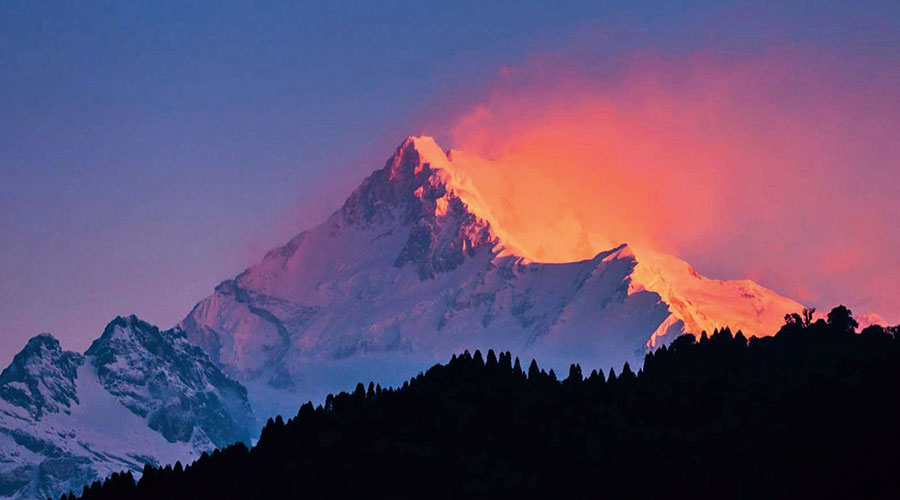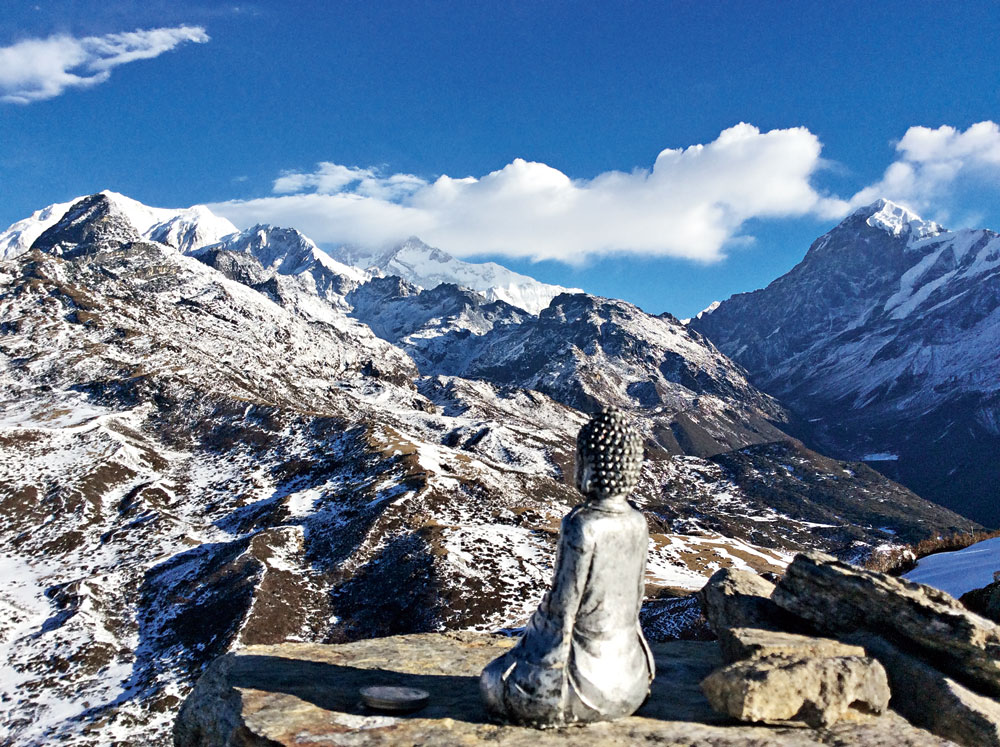The Dzö-nga has been in a benevolent mood. Kanchenjunga, the home of the mountain deity, Dzö-nga, held in reverence by Lepchas, Nimbus, Tibetans and other ethnic groups, condescended to offer majestic glimpses to its devotees in late October and early November this year. Sightings were reported not only from Darjeeling, Sikkim, Kurseong, Kalimpong and Siliguri but also — somewhat unexpectedly — from Raiganj and Islampur in North Dinajpur. The descriptions of these sightings have been as diverse as the settings. One excited viewer — a celebrity — presumably seated on the rooftop of Darjeeling’s famous eatery, insisted that the Kanchenjunga resembles a giant ice cream. Another visitor, spellbound by the glistening mountain in the silvery light of a full moon, was convinced that the Kanchenjunga looked like a ‘gigantic white elephant’.
‘Raibahadur’ Indranath Roy Chaudhuri — he had waited 17 days for a peek of the peak in Satyajit Ray’s Kanchenjungha — would have snorted at the crudeness of the popular imagination. The Raibahadur’s rage has context. The Himalayas — the Kanchenjunga is a Himalayan range — Raghab Bandopadhyay had observed cheekily in his introduction to Upendrakishore Ray Chowdhury’s wonderful, concise book, Darjeeling, transcend geography, casting their long shadow on the realms of Bengali philosophy and aesthetics. Imagining the mountain as an ice cream or a pachyderm can assault refined senses nourished by, say, Upendrakishore’s enchanting sketch of the Kanchenjunga in ruby tones or by literary passages — Mohanlal Gangopadhyay’s Dakshiner Baranda being the text cited here — that describe, poignantly, Abanindranath Tagore, a burning cheroot on his lips, gazing, as if in a trance, at the mountain on a wintry morning as the Kanchenjunga changed colour in waves of light.
The brilliance of Satyajit’s Kanchenjungha lay in girding aesthetics with a moral fence. In the film, the mountain — a pristine entity — seems to reflect the failings of puny humans in pairs: an anachronistic patriarch and his docile, suffering wife; an adulterous woman and her gambling husband; a bachelor pursuing a young woman, Monisha, who is, in a manner of speaking, the proverbial chalk to his cheese. The cinematic plot is made to defer to the moods of the mountain; light bringing in ephemeral moments of tranquility in the lives of these flawed men and women while shadows and mist — the Kanchenjunga is a notoriously fickle deity — portend disruptions.
But Ray’s moral enquiry is not limited to the tides of men. It embraces contemporary ecological crises, transforming the film into an environmental treatise. Roy Chaudhuri’s brother-in-law, an amateur ornithologist, confesses to lying awake at night, thinking of migratory birds dropping dead — like rain — from radioactive skies; Monika’s suitor can barely repress his excitement as he rants about dams — an image integral to the enduring iconography of industry taming nature in post-colonial India — even as the young woman looks away, towards the mountain. Kanchenjungha, made in 1962, is thus invested with a distinct, profound — and prescient — environmental consciousness, communicating a vision that echoes the conviction of the soldiers of ecological romanticism, from William Wordsworth, John Ruskin — the man who shaped M.K. Gandhi’s life, philosophy and politics — and Edward Carpenter to, most notably, Verrier Elwin. These thinkers, apart from being trenchant critics of capitalist expansionism, unabated consumption and the deleterious effects of industrial production on the ecology, upheld the idealization of the environment as well as of primitivism, even endorsing, in Elwin’s case, the confinement of indigenous people and cultures within ‘reserves’ to avoid their contamination by modernity.
In spite of having their hearts in the right place, Elwin and Co. have been criticized for not applying their minds. Archana Prasad demolished some of Elwin’s precepts sharply and convincingly in Against Ecological Romanticism, arguing that the location of indigenous people within forests — Elwin’s seal of authenticity of the purity of their environmental ethics — is problematic since there is anthropological evidence to suggest that the retreat of the tribes into forested territory was brought about by encroachment on their non-forested land. In other words, Prasad locates India’s tribal people and their environmentalism within — albeit on the margins of — the political economy as opposed to being removed from it. The distancing that held the key to Elwin’s understanding of the untaintedness of indigenous environmentalism was, Prasad writes, the result of an eye blinkered by romanticism.
But one philosophical pillar of ecological romanticism stands firm, defiant, like the Kanchenjunga. Rabindranath, Elwin, Gandhi, Ray — Aranyer Din Ratri (1970) and his last film, Agantuk (1991), were infused with this spirit — posited their faith in the transformative, mystical power of nature. In Kanchenjungha, Ashoke, the young man who slights the Raibahadur but is befriended by his younger daughter, Monica, is made to voice this belief, an opinion shared by Ray argues the commentator, Bhaskar Chattopadhyay, who has translated Ashoke’s dialogue in the following words: “Maybe it is this place that has got something to do with it… I have never seen anything like this before. The majestic Himalayas, these silent pine-trees, this strange play of sunlight, clouds and mist. It’s so unreal, almost like a dream state. My head was in a whirl, and everything seemed to change before my eyes. As if I wasn’t myself anymore, as if I was someone special. A hero! A giant! As if I was full of courage… careless… undaunted… as if no one could stop me anymore.” Tellingly, as the mists lift and the light returns, Ray’s characters emerge from the shadows within, fatigued, not triumphant, but neither broken by the battles they have waged.
The question is this: does Kanchenjunga’s rare, spectral appearance remain an occasion for moral replenishment, for an invigoration of the spirit to mend what is broken, for the kindling of unredeemed possibilities in cultures steadily losing their organic relationships with the natural world? At a time when the human imprint is polluting the final, thinning stretches of wilderness — tourism and mountaineering are turning the Himalayas into a colossal trash bin — the Kanchenjunga must remain as a mirror of the fraying, human morality.
Else, it could well resemble an ice cream —but one that is melting on account of the fires lit by mankind.











